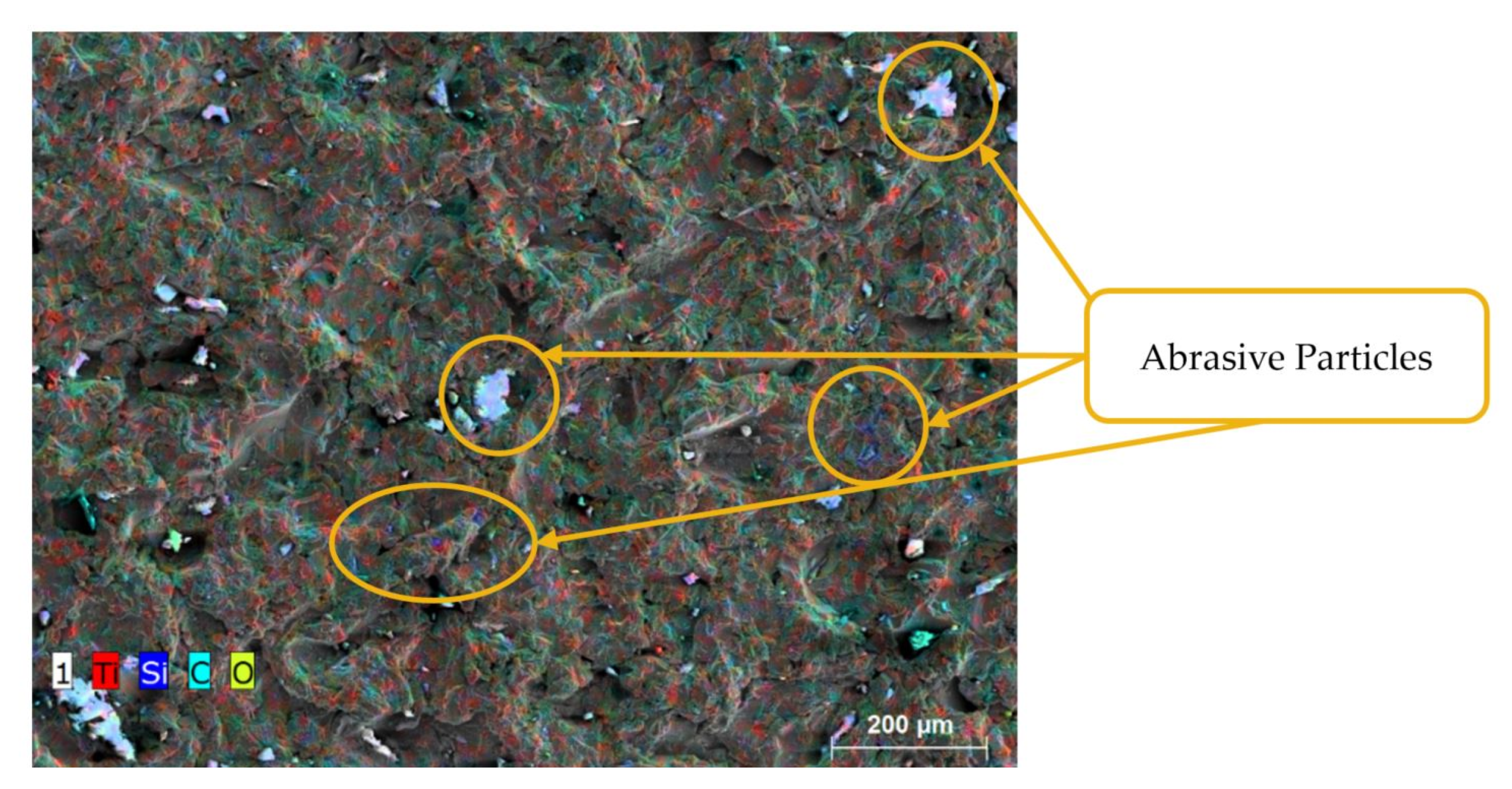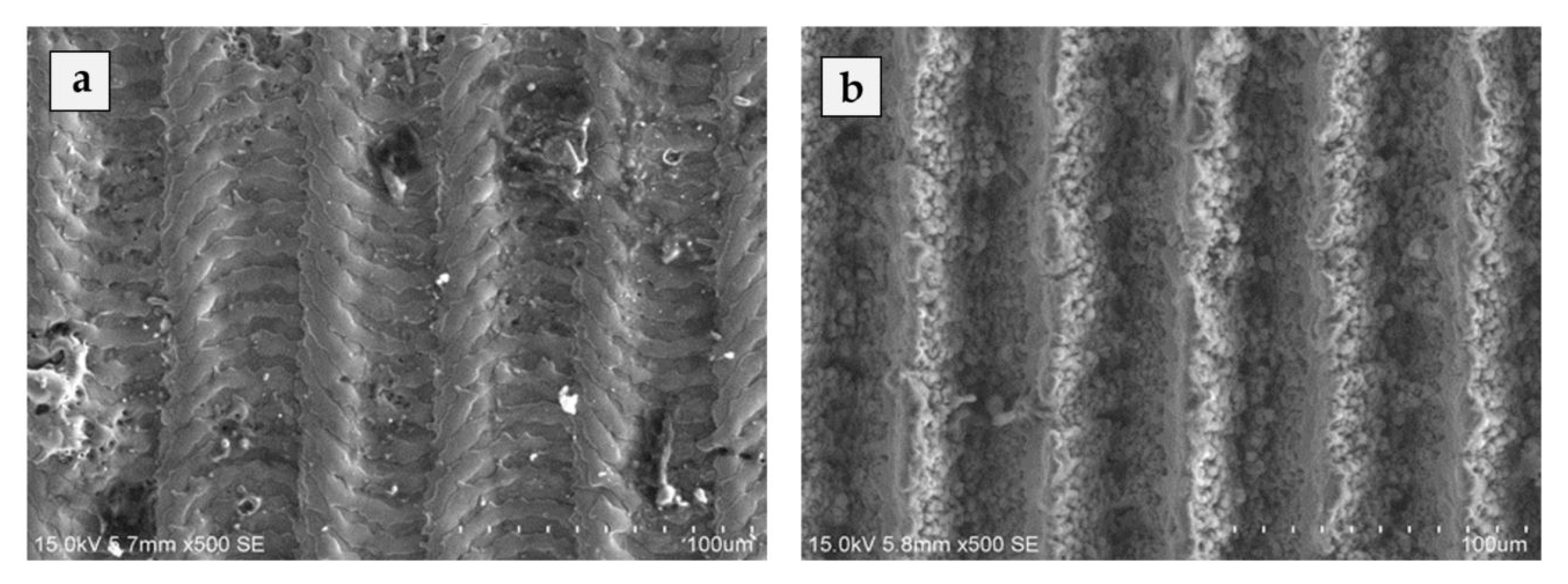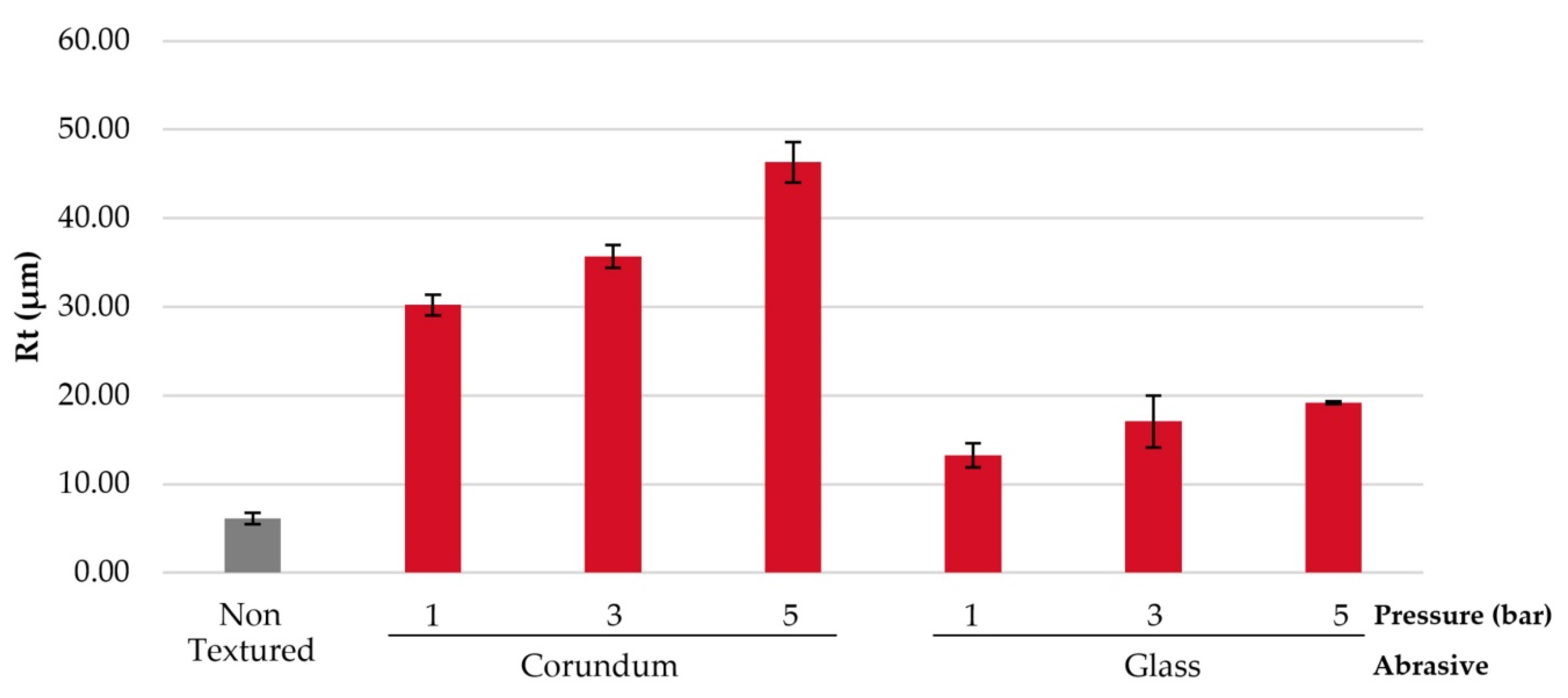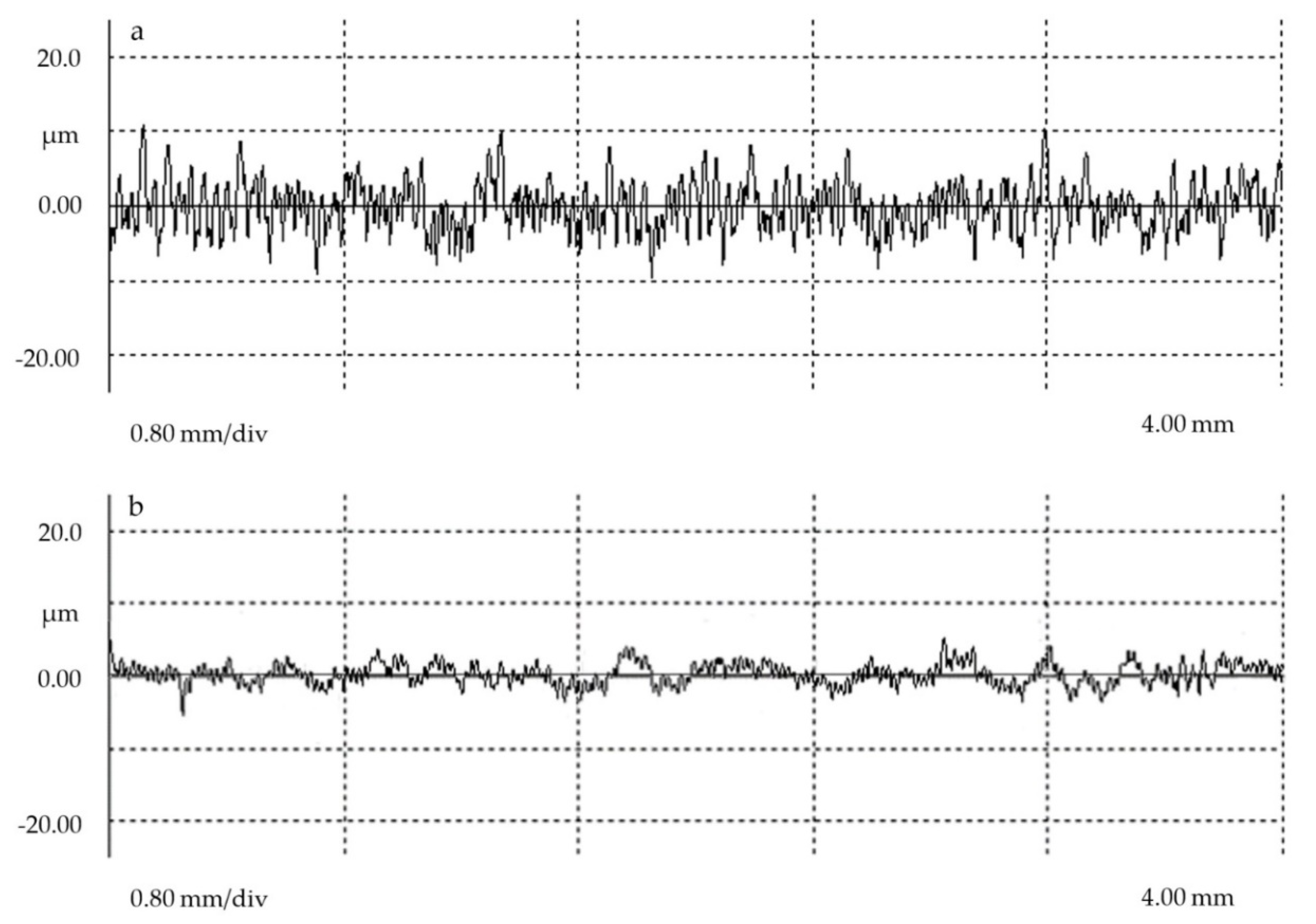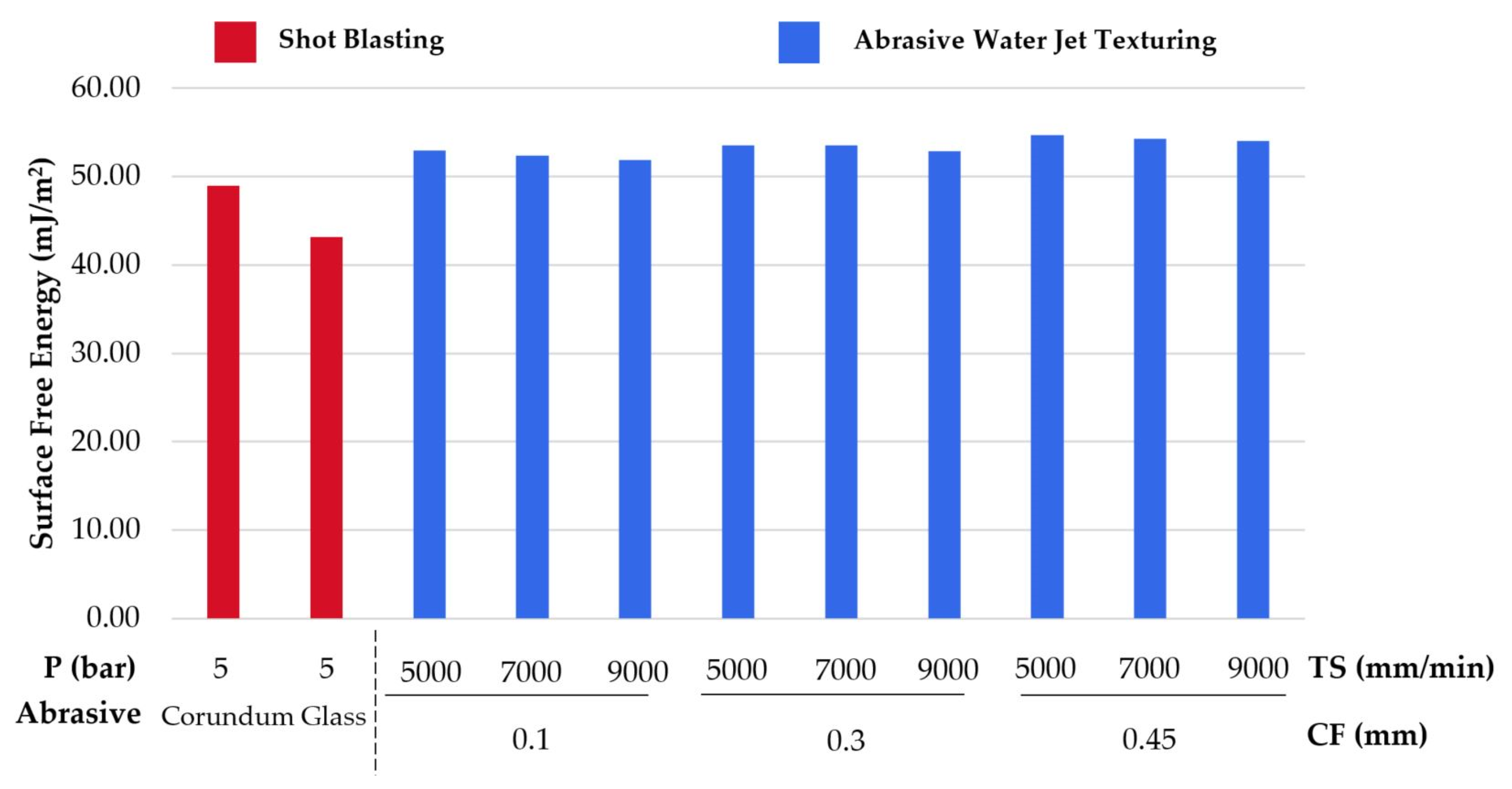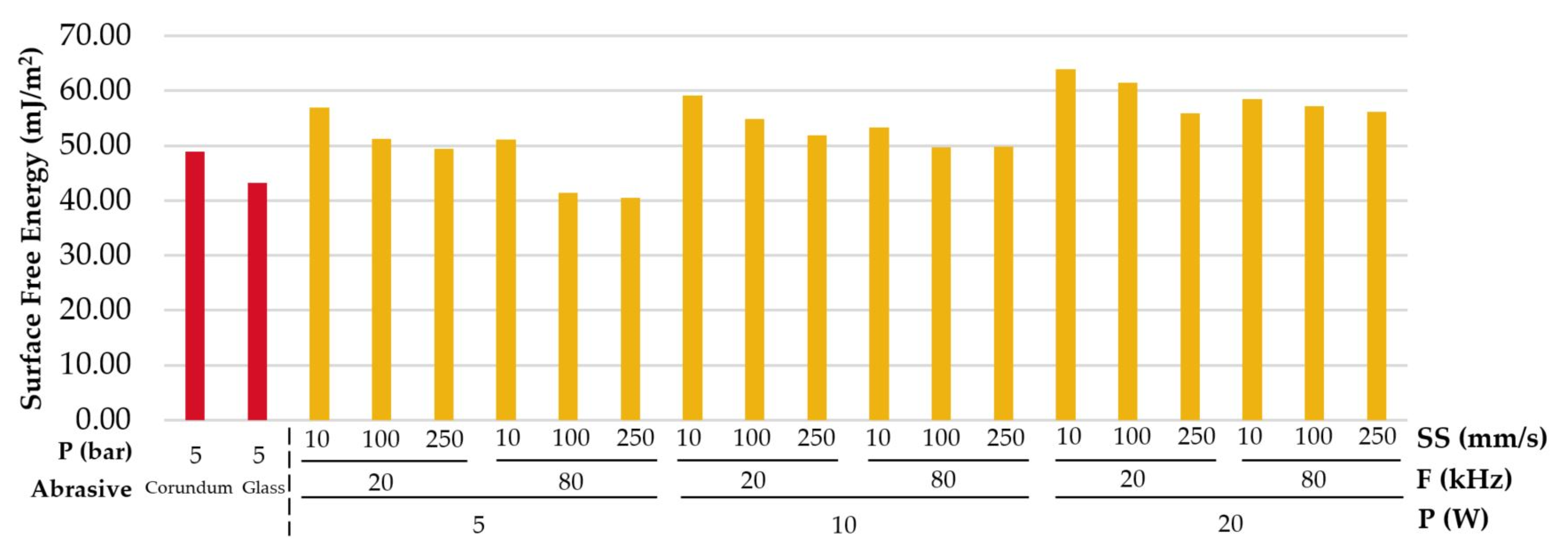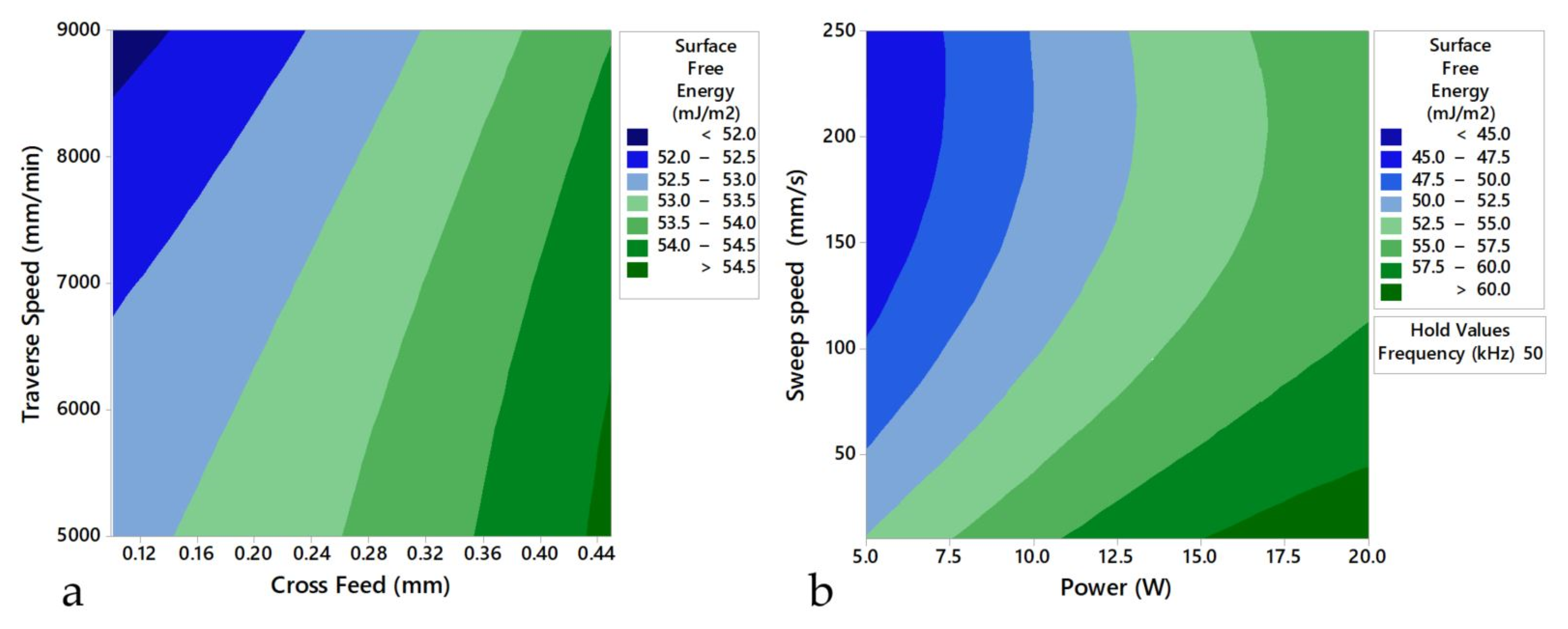1. Introduction
The modification of metal alloy surfaces to improve their functional performance is a hot research topic nowadays. The surface characteristics of these alloys make it possible to differentiate between hydrophobic and hydrophilic surfaces [
1]. The latter are of great interest in the field of material bonding.
In recent years, metal alloys have been used in the form of hybrid structures [
2,
3]. These structures are composed of dissimilar materials that complement their advantages by offering unique characteristics [
4,
5]. This has been of great interest for the aeronautical sector, where the combination of titanium or aluminum alloys with carbon fiber reinforced composites generates a structure with an excellent weight-to-mechanical property ratio [
6,
7,
8,
9]. However, the main method of joining these materials is mechanical, giving rise to a series of defects such as the concentration of stresses and the need for high-precision drilling prior to joining [
10].
For this reason, it is necessary to apply another type of joint that avoids this defectology and ensures a correct joint. Thus, bonding technologies are generating interest, capable of generating a continuous bond between both materials and, at the same time, reduce the final weight of the structure by avoiding the use of mechanical joints such as rivets [
10,
11,
12].
A hybrid structure of great interest in recent years for various industrial sectors is the combination of steel with a thermoplastic matrix composite material (CFRTP) [
13], especially in the automotive sector. CFRTPs are characterized by a high degree of automation in their manufacturing process [
14,
15]. In addition, they have excellent impact resistance which, in combination with the excellent mechanical properties of steel, produce high quality final structures that reduce the final weight of the vehicle and its consumption [
16,
17].
Nevertheless, the bonding of these materials is a major challenge. There is not much literature on the importance of factors affecting the final joint. In addition, the final state of the steel surface can directly affect the quality of the final joint. One of the most critical phases in obtaining a good bond when using adhesives is the surface preparation of the substrates. Because of this, it is necessary to ensure a very good contact between the adhesive and the adherent by modifying the latter’s surface [
18,
19].
Surface modification technologies such as shot blasting and laser surface texturing have been well studied in order to activate the surface metal alloys for further operations. In these studies, a correlation is established between the surface quality obtained with surface activation in terms of surface free energy. However, there is no specific comparison between these technologies in order to introduce improvements in the surface preparation of metallic alloys.
In this way, the degree of adhesion on the surface of the steel is directly related to its final surface quality and the free surface energy that is generated. According to the literature [
18], an increase in the roughness of the surface generated produces an increase in the peaks and valleys generated on the surface. This allows the adhesive to adhere completely to the surface, reaching a higher free surface energy value. For these reason, an increase in roughness produces an increase in the effective surface prior to joining [
20]. A relationship between roughness and parameter variation in sand-blasting was established in [
21]. Thus, the variation in roughness in steels is more dependent on the type of abrasive particle used than the variation in pressure applied. In addition, the increase in roughness through shot blasting makes it possible to obtain hydrophilic surfaces and increase the mechanical properties of the steel [
22], increasing the final quality of the joint with dissimilar materials and improving the shear resistance [
23].
Another area of interest in surface modification is the reduction of wear caused. Generating high-precision microgeometric cavities by means of different technologies such as laser texturing allows for better lubrication of these surfaces, improving their tribological properties [
1,
24,
25,
26].
On the other hand, an excess in this roughness can be negative. If the cavities generated are very high, the penetration capacity of the adhesive decreases, generating a worse bonding quality due to the formation of localized stress concentration [
27]. To achieve this, different technologies have been studied nowadays, the most interesting being shot blasting and laser surface texturing. To determine the type of surface generated, wettability tests have been performed and by means of the Owens–Wendt–Rabel–Kabele (OWRK) equation the free surface energy can been determined [
28].
Campos et al. [
29] studied the application of different types of milk in steel samples to determine the degree of adhesion of Enterobacter sakazakii bacteria in these samples. For its evaluation, they studied its adhesion based on the contact angle obtained and the free surface energy that the steel presented when depositing these liquids. It is necessary to understand and be able to control the texture generated in solids in order to be able to modify their adhesion capacity according to the desired needs.
In this sense, the superficial modification of a carbon steel by laser surface texturing was able to reduce the contact angle on that surface, increasing the polar component and, therefore, the free surface energy [
30]. In this way, Lawrence et al. corroborated that these type of techniques are capable of activating the surface of the substrate, increasing its free surface energy and its binding capacity. In this study, the results of an untreated carbon steel were compared with a laser-modified one. A reduction in contact angle from 64° to 23° was observed, which is directly related to an increase in free surface energy. An increase in both components was obtained, reaching values of 66.2 mJ/m
2 for the dispersive component and 6.6 mJ/m
2 for the polar component.
The influence of different methods of mechanical origin to prepare a carbon steel surface for the purpose of studying its degree of adhesion by peel tests has also been studied as in [
31]. In this study, he related the surface quality obtained with the wettability and free surface energy through the contact angle test. The influence of surface quality on tensile strength offered by carbon steel samples stands out. Up to a value of 21 µm of roughness produces an increase in the resistance shown by the adhesive adhered to the modified surface of the steel. However, an increase in this value led to a decrease in this resistance.
Additionally, in [
31], a correlation between these roughness values coincide with the highest values of free surface energy obtained through blasting techniques for different particle sizes. Thus, the application of garnet particles of size between 30 and 60 produces the minimum contact angle, with a value of 19.7° and a free surface energy of 64.8 mJ/m
2.
A relationship between the free surface energy generated by different blasting conditions and the surface quality obtained has been carried out by Santhanakrishnan et al. [
32]. In addition, it studies the correlation of this parameter with the mechanical resistance offered by the joint of a carbon steel with a composite material reinforced with glass. Free surface energy values close to 30 mJ/m
2 and surface qualities of almost 2 µm in terms of Ra are achieved. Santhanakrishnan highlights that that an increase in the pressure of the shot-blasting generates an area of greater roughness. In addition, samples with the lowest Ra values offer the worst contact angles and less free surface energy.
Abrasive water jet machining [
33] as a texturing technology can be a technology capable of modifying large surfaces in a controlled manner and with shorter texturizing times than those obtained by blasting and laser texturizing.
In the study carried out by Artaza et al. [
34], the surface of an s235 steel was modified by abrasive water jet prior to bonding to a thermoset composite material. The hydraulic pressure and the cross feed of the water jet were modified. In this study, Sz values of 110 µm were reached, which would indicate a high degree of subsequent adhesion.
On the other hand, abrasive water jet texturing can be a technique capable of improving the surface quality of metal parts manufactured by 3D printing [
35]. In addition, residual compressive stresses can be induced by this technique. The textured metal consisted of a Ti6Al4V alloy using hydraulic pressures of 3000 bar and feed rates of 3000 mm/min and 6000 mm/min. In their study, Pahuja et al. obtained Sz values of 118.5 mm, results close to those obtained by Artaza el al. [
34].
However, there are no studies that relate the influence of surface quality and input parameters to the free surface energy generated. In addition, there is little information on the final state of the surface generated during this process and the possible inclusion or adhesion of abrasive particles on the surface [
36].
In order to obtain surfaces with improved tribological properties and high surface activation for subsequent bonding operations, this article proposes the study of surface quality and free surface energy by the application of three different liquids on modified surfaces. For this purpose, the results obtained by means of three different technologies have been compared: shot blasting, abrasive water jet texturing and laser surface texturing. In addition, the influence of the established parameters has been determined by means of an ANOVA analysis and a series of contour diagrams have been obtained. Finally, the best combination of texture parameters has been indicated for each technology, as well as the type of surface obtained.


